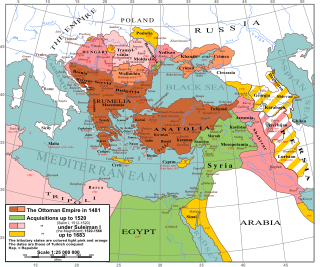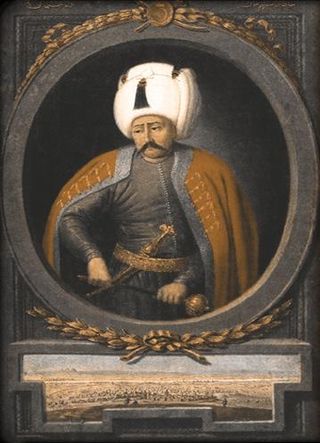
Bey is a Turkic title for a chieftain, and an honorific, traditionally applied to people with special lineages to the leaders or rulers of variously sized areas in the numerous Turkic kingdoms, emirates, sultanates and empires in Central Asia, South Asia, and the Middle East, such as the Ottomans, Timurids or the various khanates and emirates in Central Asia and the Eurasian Steppe. The feminine equivalent title was begum. The regions or provinces where "beys" ruled or which they administered were called beylik, roughly meaning "governorate" and/or "region". However the exact scope of power handed to the beks varied with each country, thus there was no clear-cut system, rigidly applied to all countries defining all the possible power and prestige that came along with the title.

The Karamanids, also known as the Emirate of Karaman and Beylik of Karaman, was one of the Anatolian beyliks, centered in South-Central Anatolia around the present-day Karaman Province. From the mid 14th century until its fall in 1487, the Karamanid dynasty was one of the most powerful beyliks in Anatolia.

The Candar dynasty or the House of Candar, Beylik of Candar, Principality of Candar, also known as the Isfendiyar dynasty (İsfendiyaroğulları), Beylik of Isfendiyar or Beylik of Sinop, is an Oghuz Turkic princely Anatolian dynasty that reigned in the territories corresponding to the present-day provinces of Eflani, Kastamonu, Sinop, Zonguldak, Bartın, Karabük, Samsun, Bolu, Ankara and Çankırı in the Republic of Türkiye from 1292 to 1461. The region is known in Western literature as Paphlagonia, a name applied to the same geographical area during the Roman period.

Anatolian beyliks were small principalities in Anatolia governed by beys, the first of which were founded at the end of the 11th century. A second and more extensive period of establishment took place as a result of the decline of the Seljuq Sultanate of Rûm in the latter half of the 13th century.

The Eyalet of Egypt operated as an administrative division of the Ottoman Empire from 1517 to 1867. It originated as a result of the conquest of Mamluk Egypt by the Ottomans in 1517, following the Ottoman–Mamluk War (1516–17) and the absorption of Syria into the Empire in 1516. The Ottomans administered Egypt as an eyalet of their Empire from 1517 until 1867, with an interruption during the French occupation of 1798 to 1801.
Suleiman Pasha may refer to one of the following persons:

Cezayirli Gazi Hasan Pasha or Hasan Pasha of Algiers was an Ottoman Grand Admiral (1770–90), Grand Vizier (1790), and general in the late 18th century.

The Ramadanid Emirate was an autonomous administration and a de facto independent emirate that existed from 1352 to 1608 in Cilicia, taking over the rule of the region from the Armenian Kingdom of Cilicia. The emirate was a protectorate of the Mamluk Sultanate until the end of 14th century, then it was de facto independent for more than a century, and then, from 1517, a protectorate of the Ottoman Empire. The capital was Adana.

Alaiye (علائیه) is the medieval Seljuq name for Alanya. It refers to the city-state in a specific period and the beylik which developed around there, at times under the Karamanid dynasty. After the 1242 Battle of Köse Dağ, the Seljuqs lost control of the city, and it became semi-autonomous.

Qāżi Aḥmad Burhan al-Din was vizier to the Eretnid rulers of Anatolia. In 1381 he took over Eretnid lands and claimed the title of sultan for himself. He is most often referred to by the title Qadi, a name for Islamic judges, which was his first occupation.
Ibrahim II was a bey of Karaman.
Mehmet II of Karaman, Mehmed Beg, Mehmed Beg II, also known as Nasir al-Din Mehmed Beg was the ruler of Karaman in what is now modern Turkey in the 15th century. His mother was Nefise Hatun, a daughter of Sultan Murad I.
Ali of Karaman was the bey of Karamanids in what is now modern Turkey in the 15th century.
Musa of Karaman, a.k.a. Hacı Sufi Burhanettin Musa, was a bey of Karaman Beylik, a Turkish principality in Anatolia in the 14th century.
Alaeddin Ali of Karaman was a bey of Karaman Beylik, a Turkish principality in Anatolia in the 14th century. Like most other Karaman beys, Ali Bey was a rival of the rising Ottoman Empire, and the two principalities engaged in chronic wars against one another.

Ottoman wars in Asia refers to the wars involving the Ottoman Empire in Asia. Ottoman Empire was founded at the beginning of the 14th century. Its original settlement was in the northwest Anatolia where it was a small beylik (principality). Its main rival was Byzantine Empire. In 1350s Ottomans were able to cross the Dardanelles strait and eventually they conquered most of the Balkans. Although they mainly concentrated their expansions in Europe, they also expanded their territories in Asia, mainly in Fertile Crescent and Arabian peninsula.

The Ottoman Empire was founded at the beginning of the 14th century. Beginning in the 16th century, it also began acquiring possessions following series of wars in coastal North Africa.
İsfendiyar, was a prince of the Candaroğulları that reigned as Bey of the Beylik of Candar from 1385 until his death in 1440.
Hatice Halime Hatun, also known as Alime Hatun or Sultan Hatun, was a princess of the House of Candar as daughter of Taceddin Ibrahim II Bey, ruler of the Beylik of Candar, and consort of Sultan Murad II of the Ottoman Empire.










